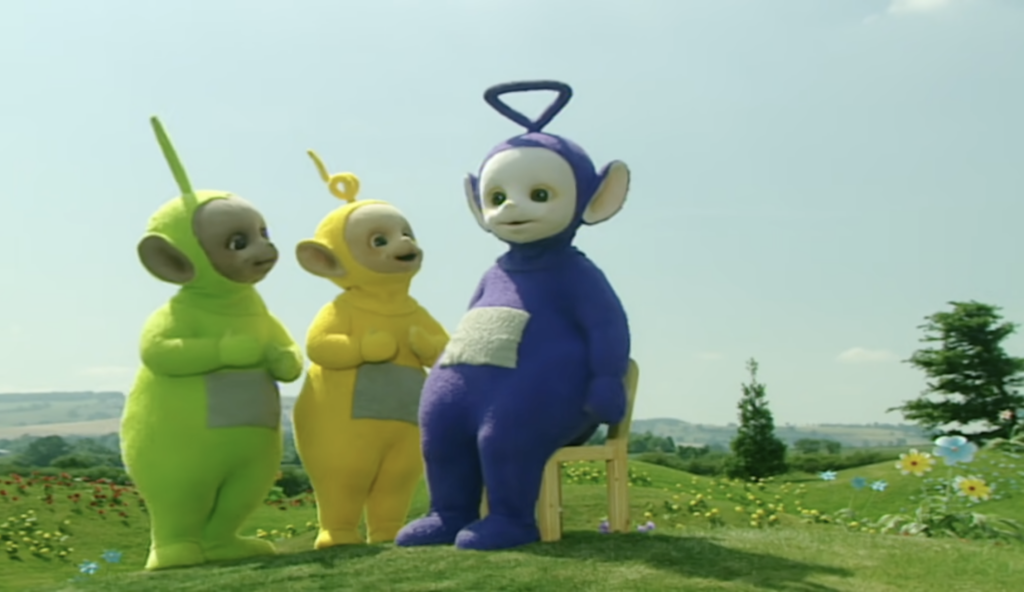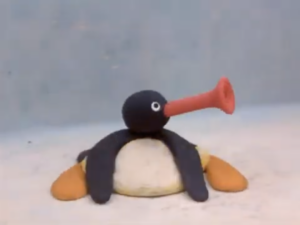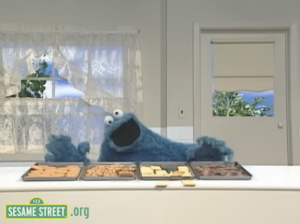Toys in the TV

There is another kind of television. It’s not quite live action, nor purely animated. It exists in three-dimensional space, yet people, in their conventional forms, are absent, and the stories and characters don’t fit neatly into our practical world. It makes sense that we find this kind of television in the children’s category, because that’s where we leave most irrational things.
Toys, especially ones designed for make-believe play, occupy a similar middle ground. Toys are real objects that you can touch, but they don’t work in the way nontoys work. You have a toy elephant, but you don’t have an elephant. You have a toy vacuum, but not a vacuum. If toys are soft, plush, rounded, and malleable, with holes and faulty parts, so are the worlds we create for them. We might watch this happen on TV.
Costume
The role of logic in the world of Teletubbies is unclear. Sometimes, the show seems overly dedicated to the principles that structure real life. Po learns that she cannot slide up the slide, because slides are for going down. Dipsy walks away from home, and therefore must walk back again. At other times, these rules are abandoned. Tinky Winky is able to fit a piece of Tubby Toast, a cow-print top hat, a large orange ball, and a scooter all in his small red purse.
Each episode of Teletubbies isolates a very simple action—one of the basic units of everyday life. The Tubbies look in the mirror, hold hands, or take turns sitting in a chair. There are four of them, the eight-foot-tall creatures, each with a unique color, signature accessory, and slightly differentiated personality. Actions sometimes produce consequences, and conflict (which itself is rare) will only sometimes find a meaningful resolution. When the Teletubbies can’t decide what to eat, for example, they go outside.
It’s beautiful here in Tubbyland. Like a normal field in the English countryside, but special. Decorated with plastic flowers and dotted with bunnies, the terrain is enhanced with small ski mogul–like hills. The Tubbies live in a grass dome that emerges from a depression in the landscape. Its interior is decorated in a futuristic style, with a toaster, a custard machine, and a control center fashioned with levers and buttons that have unspecified functions. The sky, which happens to also be our sky, is partly to mostly cloudy, depending on the day. If you look far enough into the distance, the grass becomes more muted and brown, where Tubbyland merges into ordinary farms.
Before long, the magical windmill spins, indicating that it’s time to watch TV on your stomach. Each episode, one of the Teletubbies is selected to have a short live-action segment broadcast on their stomach-screen. This is a great privilege and a curse: the honor of featuring the video, but the challenge of having to watch it upside down.
Each of these TV clips shows real-life children completing normal activities. Drawing cacti, digging for potatoes, having a barbecue. After the clip ends, the Teletubbies yell “Again! Again!” and the clip repeats. No, the recording isn’t messed up—the Teletubbies, like children, are naturally drawn to repetition, unconcerned that it disrupts the flow of the episode.
The Teletubbies like to watch us, and we like to watch the Teletubbies. Does it matter that somewhere, deep inside the Tubby, is a human actor (if you can call it that)? On the back of each Tubby is a raised piece of fabric covering up the closure of the suit. The separation between the headpiece and the body is equally obvious. These details beg to be edited out or smoothed. Yet these disruptions don’t point to the human inside the Teletubby as much as they suggest a different comparison: a toy.
The Teletubby suit itself—lumpy, soft, bulbous—withstands its human interior. It is more toy than human. This is intentional: the four-foot-long Flemish Giant rabbits were selected to make the Teletubbies appear comparatively toy-size. Yes, Teletubbies look like aliens, or babies, but they mostly look like toys.
Like all toys strewn across a playroom floor, the Teletubbies really do exist. There, in the field, being filmed in front of the camera. The set is real—so real that it was intentionally flooded by its owner after an influx of fans trespassed onto her cattle fields in an attempt to reach Tubbyland.
And like toys, the Teletubbies are also not real, not distinctly alive, with no place in our physical, human world. The Teletubbies, as we see them, are more than a sum of their parts (the actor, the suit). The hybrid Teletubby mirrors the process by which we animate toys through our imagination—giving them life and using them to test out what things are supposed to do and mean. Hence the logical holes poking through Tubbyland. This is all an experiment—these are just toys. Rules will be picked up only to be put down again. And again, and again.

Clay
Pingu, the penguin protagonist of his namesake series, lives his life through pure, raw emotion. He is a very bad penguin. Blind to consequences, he acts impulsively, triggering tears, wounds, and scoldings. His major irritants are typical of any young boy: a younger sister who gets too much attention, rules, bullies, the seaweed he has to finish before leaving the table. What is not typical of Pingu is that he’s made of clay.
Specifically: soft, matte plasticine with the texture of fondant. Few things are made of clay, but at the same time, clay can be made into anything. In Pingu, this means: tables, chairs, planks of wood, igloos, mailboxes, sleds, red balls, popsicles, lollipops, fish, fishing poles, hats, accordions, barrels, baskets, pillows, popcorn, packages, straws, stilts. A world made from clay is not realistic (everything has rounded edges), but in many ways, it is preferable.
In the South Pole dollhouse arena where Pingu’s dramas unfold, things stretch, bend, spread. The world we live in doesn’t really move like clay, but when it does, here on the screen, it moves better. It feels good to hold clay, to squeeze it, roll it, flatten it out, break it apart. It feels good to watch clay move like this, as if my hands were inside the screen. Clay needs human touch to warm up before it changes shape. Pingu needs our warm hands.
Meanwhile the characters speak in Penguinese, an uninterpretable language that sounds like talking but doesn’t say any words. Only the sensory qualities of language remain. It’s surprising how well this works: full exchanges decipherable only through tone and gesture.
It turns out that clay is perfectly suited for slapstick comedy. Pingu sleds down the hill so fast that he crashes inside a snowman—we watch the base of the snowman stretch as he tries to push himself out. He flips over his fishing hole like a Slinky, catching his friend Robby the Seal stealing his fish behind him. Luring the seal out of the ice hole with a piece of seaweed tied to a string, Pingu chases him by rolling his entire body into a perfectly cylindrical ball. When Pingu falls onto the ground, he flattens on impact.
Animators call the freedom of movement in claymation “squash and stretch.” Characters change shape as they move. This kind of stuff happens in cartoons all the time, but the effect seems more extreme in three dimensions—in the clay that we can feel in our hands.
Other fictional worlds limit their characters’ expression to movement of the eyes, mouth, and limbs, but Pingu characters emote with their whole bodies. When Pingu is surprised or overwhelmed, his body melts into a puddle. When he wants to intimidate someone, his torso stretches and his shoulders expand. His signature expression, “Noot Noot,” erupts from his beak as it stretches into the shape of a trumpet, expressing a range of extreme emotions from excitement to anger.
Though exaggerated, the reactive morphings of Pingu’s body never feel unrealistic. Emotion has a tendency to manifest physically. Emotion is a kind of exaggeration in itself—it stretches, it shrinks, it melts into the ground.
Pingu’s mischief brings consequences, then tears. Fat, white, opaque tears that rest for a moment on his face. Again: sadness is physical. Clay is soft, but not because it is gentle. Clay has a quality of softness that promises flexibility. The opportunity to be something, and then be something else. In the next few frames, tears roll away. Pingu bounces back.

Hands
Cookie Monster was discovered, in a way, on a game-show segment in the first season of Sesame Street, called “The Mr. and Mrs. Game.” A blue monster and his wife appear on a game show. His voice sounds like a used car salesman’s. When they win, they are offered the choice between ten thousand dollars, a new house, a three-week vacation in Hawaii, or a cookie. He chooses a cookie, and there’s no coming back from that.
Cookie Monster would not consider his timeless bit a bit. After all, the only way Cookie Monster can understand his world (the number three, the moon, the word there) is by thinking about it through cookies (three cookies, it’s a good thing the moon is not a cookie, there are cookies there). To the librarian’s dismay, he is unable to request a book without also requesting a box of cookies. His letter to Santa says it all: two dozen coconut macaroons, a pound and a half of “figgy newtons,” four dozen oatmeal cookies, banana cookies, chocolate-covered-marshmallow-with-jelly-inside cookies. He has to stop there because he has become so hungry he has eaten his pencil.
It takes two to “animate” Cookie Monster, who is a live hand puppet, unlike a rod puppet (Elmo) or a wearable puppet (Big Bird, Snuffy). Cookie Monster is also referred to as a bag puppet, which seems right—he is basically just a giant bag. One puppeteer uses both of their hands, one in Cookie Monster’s head and the other in the left arm, and another puppeteer controls his right arm. In review: Cookie Monster’s hands are human hands, his arms are arms, but then his head is also a hand. “The hand speaks to the brain as surely as the brain speaks to the hand,” you can read in a book called The Hand.
Puppets are fidgety. This has a physical explanation, because a human arm and hand have more mobility than a torso and head. It’s also a coping mechanism, making up for the absent faculties of facial expression and body language.
Cookie Monster flaps all over the place, repeatedly showing us the dark hole that is his mouth. No one’s face moves like that, which makes sense because what’s moving is actually a hand. Cookie Monster is grabby, catchy, punchy. It’s not a coincidence that these adjectives also describe actions completed by a hand.
In another children’s show, Oobi, the hand-mouth relationship is interrogated. Instead of placing their hands inside the puppets, the puppeteers’ hands function as the puppets themselves, with the sole addition of a pair of glass eyes. Picture a puppet, but naked. These puppets can do all the typical kids’ show things—play, explore, navigate simple conflict. They can also do all the typical puppet stuff: talk, look around, move up and down. The thumb sometimes becomes an arm, or a hand, scratching the side of the head in confusion. The mouth of the characters takes a break from being a mouth to become a hand and carry something—say, a toolbox—into the scene. We have decided, with certainty, on what our body parts can do for us. But then we find it’s easier to relate to a mouth that is actually a hand than to a mouth that is truly a mouth.
Something is off: these characters composed of human flesh feel more alien than the matted blue Cookie Monster. With a ratty, loose bag over his head, Cookie Monster looks like a well-loved toy. His movements are not dissimilar from those of a toy handled by a child, its body grasped and shaken around to imitate speech during play. Would you call eating all the cookies a character flaw? Cookie Monster might think about this, and then shake his head no. Which means that someone, under the blue fur, is waving goodbye, or maybe hello.
Isabelle Rea is a writer who lives in New York.
